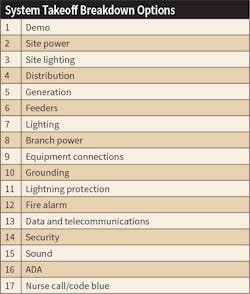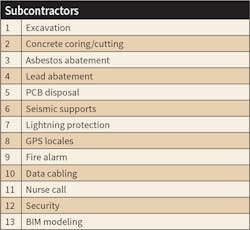In part one of this column in the February 2018 issue, we looked at the estimate preliminaries that are necessary to put together a solid estimate, which were summarized in five steps. Once the preliminaries have been completed, the estimator’s main responsibility shifts to quantifying that estimate. Depending on the project size, this will require a lot of counting and measuring. Let’s see what’s involved in this process.
Step 6: Perform all counts for package quotations.
Basic materials, such as conduit, boxes, wiring devices, and wire, are typically priced through a service with most leading brands of estimating software. However, items such as luminaires, panels, generators, and fire alarm systems will need to be quoted through local vendors. That’s why it’s important to establish a good working relationship with several electrical suppliers. Having several quotations on bid day will help you know if you’re getting the right pricing levels.
A manufacturer’s representative can also provide great support to electrical contractors during the bidding process. This is especially true if you are required to modify existing equipment. For example, if the project requires you to install a 2,000A breaker in an existing switchboard that was installed in the 1970s or 1980s, a manufacturer’s representative will be valuable in finding the right components.
Getting your quantities for all quoted packages as early as possible will give your vendors plenty of time to review specifications and schedules. Some prefer to perform counts for their own systems. However, it’s a good idea to send vendors your own quantities. This would include, but not limited to: luminaires, gear, fire alarm, security, data communications, heat tracing, surface raceways (if a large quantity), and sound.
By counting the luminaires first, the estimator can get familiar with the project early. When counting luminaires, the estimator should balloon panel locations with a highlighter, a technique that will prove beneficial once you begin taking off the branch wiring for each system.
If possible, wait until you have completed your takeoffs to send your quantities to suppliers. If you’re under time constraints, then send them right away (as outlined in Step 8).
Step 7: Perform all takeoffs systematically.
Once you have counted all equipment that will be quoted by vendors, you’re ready to finish the quantifying process. Performing takeoffs systematically will minimize mistakes. Estimating each system completely is best. Jumping from lighting to the fire alarm system, for example, will provide the perfect scenario for making mistakes and omissions.
Having a systematic order is more important than the actual order. Having an order that is consistently followed is paramount. Arrange an order that best suits your own estimating style, and follow it every time. Table 1 shows a suggested breakdown list of possible systems the average commercial project may have.
A commercial project will have a different list of systems compared to an industrial project. Be sure to customize your project to specific conditions. Having your takeoff broken down by specific systems will allow you to analyze each component of the estimate and scrutinize it for mistakes and omissions.
Step 8: Send quantities, schedules, and one-line diagrams to suppliers.
Once your estimate is complete, send all luminaires, panels, switchgear, and device quantities to your suppliers. A good estimating program will allow you to copy and paste this from your extension screen into your email.
When emailing quotation requests to vendors, be sure to include all applicable sections of the specifications, panel schedules, and one-line drawings. Your request should include the date the quotation is needed as well as any individual pricing that may be required to bid the project. Avoid last minute pricing requests. This may cause you not to receive proper pricing from your vendor.
Step 9: Send quotation request for specialty items.
Most projects will have a handful of specialty items that require quotations, some of which might include: high voltage cable, cable trays, cord reels, hand dryers, and specialty floor boxes. Some of these items may need to be quoted from a different vendor than your lighting supplier.
Inform your supplier regarding the quantity of each of these items — most of the time these items will have a lower unit price with larger quantities. Most engineers will usually provide details on the drawings for these speciality items. These detail drawings should be provided to your vendors, quoting your specialty items along with specification information.
Step 10: Send quotation requests with scope of work to subcontractors
Send a quotation request as soon as possible to your subcontractors. The request for quotation (RFQ) should include the following: project name and location, bid date, time, and any required price breakdowns.
You should provide your subcontractor with a complete scope of work that you need included in your quotation. For example, a scope of work for an excavator should include trench widths and depths, asphalt removal and repair, concrete encasement requirements, excavation requirements for site lighting bases, and pad-mounted transformer equipment pad requirements.
Send your subcontractor all drawings and spec sections related to his work. Be sure to check all drawing notes that may provide information related to this work. Table 2 shows a suggested list of possible subcontractors on an average electrical project.
Summing it all up
Following steps six through 10 will allow an estimator to completely quantify the project and request all the necessary equipment and subcontractor pricing necessary to summarize the estimate. Not every system or subcontractor will apply to every project, so analyze your project and set up the takeoff process that streamlines the project you’re bidding.
In the next article, scheduled for the June 2018 issue, we will learn how to check and summarize the estimate and arrive at a final price for bidding.
Kiper is an independent electrical estimating trainer and consultant based in Niagara Falls, N.Y. He can be reached at [email protected].





